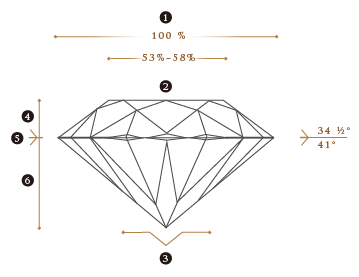 Diamonds
Diamonds
 Pearls
Pearls Tailored
Tailored Diamonds
Diamonds
GIA
Founded in 1931, GIA is a professional institution and America’s authority on gems. GIA is a nonprofit research institute that provides gemological education.
The educational foundation works to ensure public trust and serve the global gem and jewelry industry. GIA provides knowledge and expertise to maintain the jewelry industry’s stability and integrity, and uses a combination of faith, science, and learning in order to create the non-profit services.
4C
The founder of 4C is well-known for establishing the diamond 4Cs (color, clarity, cutting, and carat weight). The organization is also the birthplace of the International Diamond Grading System. Today, GIA’s color grading of D to Z and clarity grading of FL to I3 are recognized as the global standards of professional jewelers and diamond buyers.
 Cuts
Cuts










The cut refers to the diamond shape, proportion, and modification. If a diamond has a delicate cut, regardless of any shape, as long as the proportion is proper and the facet arrangement is appropriate, the light will reflect like a mirror. The different facets reflect and agglomerate light at the top of the diamond to produce an irresistible fire. Therefore, proper proportions and a perfect cut will give a diamond a higher value.

A well-cut diamond will reflect the light through the top surface of the diamond when light enters it. A diamond cut too thin or too deep lets light slip away at the bottom, so the diamond loses luster. Appropriate proportions and a perfect cut will give a diamond a higher value.

Perfect proportions and angles make every Super Ideal Cut diamond display the most spectacular scintillation, sparkle, and brilliance. When cut by a world-class master, each diamond has the most precise proportions and modifications to precisely control light entering the diamond. When light completely overflows from the crown, every diamond can shine the brightest light. When the Super Ideal Cut is presented, eight hearts and eight arrows naturally arise. But a round diamond with eight hearts and eight arrows does not mean it must be a Super Ideal Cut.



 Clarity
Clarity
 FL / IF
Flawless
FL / IF
Flawless VVS1 - VVS2
Very, Very Slightly
VVS1 - VVS2
Very, Very Slightly  VS1 - VS2
Very Slightly
VS1 - VS2
Very Slightly  SI1 - SI2
Slightly
SI1 - SI2
Slightly  I1 - I2 - I3
Slightly
I1 - I2 - I3
Slightly Each diamond is unique, and contains inherent inclusions such as mineral or uncrystallized carbon, etc. This is the unique mark that nature left in the creation of diamonds. Professionally trained appraisers use a 10 times magnifying glass to decide the clarity grade of diamond depending on the size, number, location, type, and color of inclusions or degree of obviousness.
Impact on beauty:
 Color
Color






Diamonds come in a variety of different colors, from transparent and colorless to light yellow, rare golden yellow, green, orange, blue, pink, and various other fun colors. But most diamonds are rendered from transparent and colorless, to nearly colorless and pale yellow. The fineness of the diamond grade begins from “D” to “Z.” Each letter represents a distinction in subtle fineness. Diamonds closer to being clear and colorless are more rare and precious and can show the diamond’s charming glory.
Impact on prices:
A difference in subtle fineness may result in an amazing price change. From an investment prospect, it is best to buy a diamond of colorless grade or nearly colorless grade. G or H diamond is already good.

 Carats
Carats
Diamond weight is counted using “carats”; 1 carat is equivalent to 100 'points.' , so a diamond of 50 'points.' weighs 0.25 karat.
Even though a carat is an element that can clearly distinguish the diamond’s value, it is not a major factor in determining the value. Two diamonds of the same size and shape will vary far in worth due to cut, fineness, clarity, and other factors.
Impact on prices:
The heavier the gem, the higher the price per carat will be because the price increases geometrically with the number of carats and because larger diamond crystals are more valuable.
For example, a senior 2carat gem is likely three to four times more expensive than a 1carat gem because of the rarity of large diamonds.
.png)
.png)
.png)
.png)
.png)
.png)
.png)
.png)
Pictures are only for reference. The actual size may be different from the size on the screen.

 Pearl
Pearl
 White
White Purple
Purple Orange
Orange  White
White Black
Black Malachite green
Malachite green Gold
Gold Round
Round Oval
Oval Drop
Drop Baroque
BaroqueThe body color and floodlight are important. In general, the four color series are white with pink, silver white, champagne, and gray. White pearls with a pink gloss are expensive, but the aesthetic feeling is the subjective experience of the individual, so there is no absolute distinction of good or bad colors and prices.
For surface quality, it is checked for purity and perfection, bead spots, and holes and cracks. Because cultured pearls are naturally occurring, it is inevitable that there are small flaws, but the size of the range, amount, depth and location will all affect its price.
When assessing the value of pearls, size is a decisive factor. In general, the larger the diameter, the higher the value is. Large pearl are scarce, so they are more valuable. For example: South Sea pearls with their impressive sizes are also known as “Queen of Pearls.”
Its size is about 8~20mm. When a pearl is more than 7mm, the size and price gap will grow.
The shapes of pearl are not necessarily the same; for example, they can be round, oval, teardrop, deformed, and so on. The values vary according to the pearl’s rarity and aesthetic beauty. The most popular shape is perfectly round, which is relatively rare, so the price is more expensive. Currently, deformed pearls are also popular on the market. The shape of deformed pearls make them a designers’ favorite, as they can be used to create a variety of shapes such as flowers, insects, and other animals, which in turn give the alternative pearls extraordinary value.
1 . Pearl needs diligent maintenance. They cannot come into contact with perfume, hair spray, or cosmetics, as the chemical change will likely cause the
1 . pearl to lose its original luster.
2 . When not worn, pearl jewelry should be wiped with a soft cloth or tissue first and then placed in a dry ventilated place.
3 . Pearls have low hardness and should not be placed with other gemstone jewelry. In order to avoid collisions and scratches, pearls should be placed and
1 . housed individually.

 D & D
D & D
International certified non-conflict diamonds are selected to make Super Ideal Cut diamonds that achieve an Excellent rating of 3, so that each ideal cut diamond can shine brightly.
 What is a Super Ideal Cut?
What is a Super Ideal Cut?
Professional jewelry designers create long-term designs for various leading fashion works. Stories and life experiences are added to make the style resonate with your heart.
 Tailored
Tailored
 Listen to the heart
Listen to the heart
Customers have ideas and designs specific to them. After understanding the preferences and needs of customers, we can help them find the best D&D wedding ring.
Diamond: D&D offers a variety of wedding ring styles for selection. You may freely mix diamond grade and size to customize the most ideal diamond.
The series of products are constantly being innovated by the linking of customers’ emotions with designers’ concepts. After the initial design sketches, the perfect diamond ring is created step by step

Once the design has been passed, artisans cast a rare precious metal to plate the customized fine jewelry.

Using tweezers and pliers, the gem inlaying master conducts fixation adjustment on the inserts for the jewel. The precision cut is undertaken by an experienced mosaic master.

Each piece has to be polished at least three times. Delicate polishing makes the surface of precious metals shine.

In about 15 working days, your ideal wedding ring will be delivered to you.
(excluding holidays)1 Offer first interior ring engraving service for free.
2 Offer free jewelry maintenance and cleaning services.
3 Offer free ring resizing (excluding platinum goods, rings can only be resized one size up and two sizes down).
